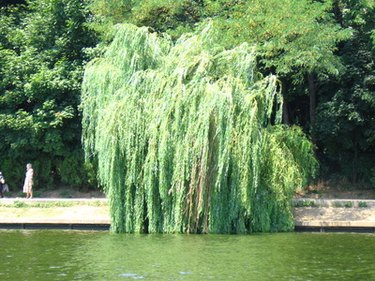
Weeping willow trees are a hardy species, growing well in both moist and dry environments. This has caused them to be invasive in many areas, with their large roots causing problems for underground plumbing and wells. These trees are overall quite resistant to pests, although they can be affected by insects such as scales, caterpillars and aphids.
Scale Insects
Video of the Day
Most people do not recognize scales as insects, because they look quite different to most others. The females and immature scales are often small and wingless, without distinction between the head and body. They can resemble a growth on the tree, because they are often immobile.
Video of the Day
Once a scale settles on a tree, it will stab its straw-like mouth parts into the tree to suck fluids. Ants can sometimes tend populations of scales, which will increase their numbers a lot. This could make these insects difficult to get rid of, but scales do not often cause much damage to willow trees.
Aphids
Aphids are small, usually wingless insects that can be green, yellow, red or brown. They move slowly but live in large numbers on a variety of plants, including willows. They can become a real problem in several different ways. They can distort and yellow leaves when they exist in large populations on a tree. They produce a sticky mucus called honeydew, on which a black damaging fungus grows.
Some aphids can cause viruses to plants, which is difficult to cure, and others inject a toxin into the tree. Overall, aphids are responsible for some unsightly damage for trees and other plants, including mottling, distortion and thick honeydew deposits.
Caterpillars
Caterpillars are the larvae of moths and butterflies. In this stage, their main form of damage to trees is severe defoliation, which could lead to tree death. Caterpillars eat the leaves almost constantly until they are ready to prepare a cocoon. They will often use the leaves for making a cocoon as well, either by rolling leaves around them or matting them together.
Galls
Galls are swellings of the actual plant or tree that are caused by a variety of insects or mites. Types of gall-making insects include wasps, flies, moths, and mites, whose secretions are responsible for the swollen leaves, branches or flowers. Galls can often be colorful and vary in shape or size depending on the type of insect that makes it.
Beetles
Several types of beetles attack leaves of trees, similarly to caterpillars. They do not only do this as larvae, however, which allows them to potentially defoliate an entire tree. They also leave behind thick dark droppings that can cover the entire plant.